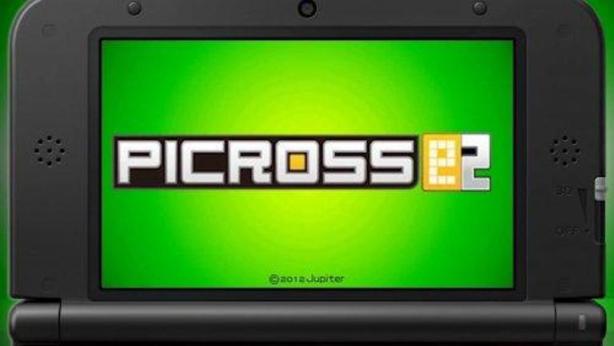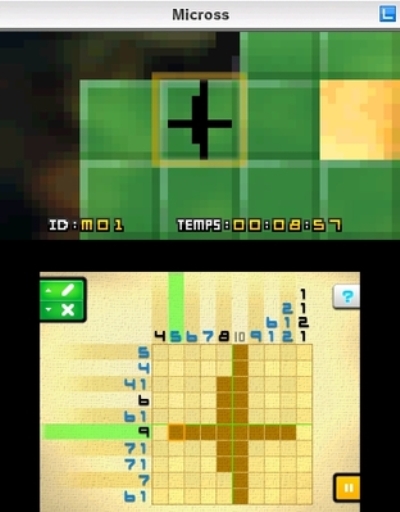
When Picross e came out back in June, I was absolutely ecstatic. I didn’t even know that the game existed, so when I saw it in the weekly 3DS eShop release list, I was pretty blown away. Being at work, I had to wait an absolutely grueling six or seven hours before I was able to get home to purchase the thing in a frenzy of picross fandom. At least, as much of a frenzy as one can get into when downloading a picross video game.
Having burned through the game’s 150-ish puzzles by the time the weekend was up, I would have been severely disappointed if I’d bought anything but a picross game. I’ll forgive picross all of its shortcomings because it’s picross and I am hopelessly in love with picross. As it is, I was only slightly perturbed that my joy had been cut short just as it was reaching a fever pitch. It didn’t last long, but I’d say I got my eight bucks’ worth.
And then at the end of July, I was blindsided again by the launch of Picross e2. Though I did know it existed and that it was on the way, I had no idea that it would show up so soon. Again, I was forced to sit at my desk for hours, running down the clock until I could get home and download me a whole new batch of puzzles. There really need to be more unsecured wifi networks around here.
Of course, this time my expectations had been tempered. I knew that I was only going to be getting as many puzzles as I’d like, and that more than likely they’d be somewhat tricky at best. But like I said, it was still more picross, and that’s always a good thing for me.
I downloaded the game as soon as I arrived home, and the trouble began as soon as I removed the cute little gift wrap that 3DS game and app icons are covered in when you download them. The sleek blue presentation of Picross e had been replaced in Picross e2 with a grotesque lime-green theme. While it was a change that I was able to eventually learn to tune out, I am still a little miffed that somebody decided on using such an ugly colour.
The only way I’d be convinced that it was a solid colour choice is if this were some kind of Ghostbusters Picross and Slimer’s dumb face was plastered all over it. That’s just not the case. And it’s kind of a shame.
As for the game itself, it’s pretty much exactly the same as the last one. There are 150 puzzles, split between normal and free modes, and the difficulty generally ranges from “Special Ed Easy” to “Might Possibly Give You Trouble If You Don’t Understand How To Play.” This game still lacks any puzzle grids bigger than 15×15 (which contributes to the lack of difficulty), and still doesn’t put its puzzles into any coherent themed sets (which contributes to the lack of whimsy).
Though maybe I’m being too harsh. There are a handful of puzzles at the tail end of the game that did make me buckle down and apply all of my elite picrossing skills. These few puzzles got downright devious and were ultimately very satisfying to solve. But really, when only a dozen of the puzzles require any sort of brain usage, that’s sort of a sad situation.

There is one huge major addition to Picross e2, and it’s not really for the better. A new mode is introduced, called Micross. I don’t know what that means for sure, as I skipped the tutorial faster than you can say “tutorials are dumb.” Micross puzzles do have a theme, and that theme is “works of art” which is pretty neat but diminished by the fact that there are only five micross puzzles.
Of course, that’s the catch. Each Micross puzzle is a little 8×8 panel, and when solved, each “chiseled” tile becomes its own 10×10 puzzle. This sounds great at face value, as it nearly doubles the amount of puzzles in the game. However, it’s really just a trick! Each and every sub-panel is so easy that halfway through I considered quitting because I felt like the game was actively insulting my intelligence. Some are so simple that the solution is a single straight line of tiles. There may have even been one in there that had a solution consiting on one tile. I believe there was a single panel in the entire Micross sub-game that required me to think at all.
So yeah, Micross sounds pretty neat on paper, but just does not work in practice. If you want to see a similar style of picross that is actually really great, go find the ROM for Mario’s Picross 2 for Game Boy. It’s exaclty what I want in a picross game.
Picross e2 does make one very, very important change for the better, though. Once you finish all the puzzles in any given category, it awards you with a little medal on the mode select screen. That’s exactly what I asked for! Good job, Jupiter! I’m not even being facetious here. Those little medals mean a lot to me. Like when you give a child a banana sticker for making his bed or whatever.
It may seem like I’ve got a bit of a grudge against Picross e2 for not being what I want it to be, but I really don’t. At the end of the day, it may be too easy for me, but it’s still a portable picross game, and one that’s a lot nicer to look at than Mario’s Picross. Has much less slippery controls, too. Somehow. I don’t know how you muck up the controls in Picross, but Mario’s Picross feels weird to me.
Anyway, if you’re looking for your next picross fix and you’ve got eight bucks to blow, Picross e2 certainly isn’t a bad way to go. It’ll scratch the itch, but ultimatly leave you wanting more. Which I guess is Jupiter’s plan, cause how else are they going to convince you to buy Picross e3?
